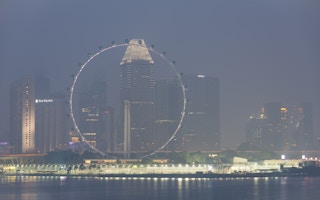The fires in Indonesia and the haze that is currently blighting the wider region are never acceptable. Fires harm the economy, the environment and most importantly people’s lives. It is also a reminder that despite having struggled with this issue since at least the mid-1990s, these fires are still burning and as an ASEAN community, we have still not found a solution. This must change.
To continue reading, subscribe to Eco‑Business.
There's something for everyone. We offer a range of subscription plans.
- Access our stories and receive our Insights Weekly newsletter with the free EB Member plan.
- Unlock unlimited access to our content and archive with EB Circle.
- Publish your content with EB Premium.
Our immediate priority must still be firefighting to bring the flames under control. Across Indonesia, with the involvement of the private sector, community groups, Indonesian government’s taskforce including the military, many of the fires are being tackled.
As the current El Niño – a climate phenomenon which brings unusually hot and dry weather, has been predicted to last until 2016, this will further compound the tragedy of forest fires. El Niños occur every two to seven years in varying intensity, that is why attention must rapidly turn to long term solutions, or these fires will continue. We need to focus on preventing fire, and it is here that the entire ASEAN region can and should play a more significant role.
What is clear from the work currently underway by organisations such as the Center for International Forestry Research (CIFOR) is that the political economy of fire – that is, the complex network of socio-economic and political considerations at the root of the issue of forest burning – means that there are no easy options. Fire is an incredibly complicated issue, but what we need to focus on is what CIFOR calls the ‘business of fire’. These fires are being driven by economic activity and we need to recognise that it is the economy that is at the heart of these forest fires. Accordingly, I believe that there are four steps that we must take to end the ‘business of fire’.
Firstly, we need to tackle Indonesia’s challenges surrounding land tenure, mapping and control. This is an issue that is also closely linked with the wider challenges facing responsible forestry in the region. Take the ‘zero deforestation’ commitments made by my company, Asia Pulp and Paper (APP) and many others which seek to end the loss of natural forest. The independent evaluation of APP’s progress conducted by the Rainforest Alliance found that APP and our suppliers had successfully halted forest clearance. However, it also found that clearance by unauthorized third parties on our suppliers’ concessions was continuing, whether due to overlapping concession rights with other businesses, encroachment in the absence of clear land rights, or illegal activity such as illegal logging and illegal land clearing using slash and burn methods.
This Rainforest Alliance finding cuts to the heart of the issues at play in Indonesia’s forests. These exist in the murky context of land conflict, where land licenses and land claims overlap, with the reality that many concession licensees are not in full control of what is happening in their licensed concessions. These illegal activities are reported to the law enforcement agencies, with several arrests already made. But this is not an isolated issue in APP concessions, and is instead a wider problem across parts of Indonesia.
Land conflict is not black and white, some communities will have genuine land claims and responsible businesses must ensure that resolutions are found. Equally, it is also clear that concessions are vulnerable to encroachment from smaller businesses operating with questionable permits, or opportunists whose sole intention is to sell the land they claim. Law enforcement is required, but this will only work if effective maps exist to show who manages what and who has rights and responsibility to the land in question.
The foundation of our zero deforestation approach is accurate mapping and high-quality data on our concession areas to identify natural forest, high conservation values, high carbon stock, plantations, peatland and areas in use by local communities or subject to competing land claims. This enables the development of a sustainable integrated plan for the land’s ongoing management.
I believe that applying a data-led approach across Indonesia’s forests is the way forward. This is why in 2014 my company shared its suppliers’ mapping data with the Indonesian Government and with independent organisations such as the World Resources Institute. Policy starts with effective spatial planning and we therefore need to encourage the development of ‘One Map’ – an initiative by the Indonesian government to produce a single, comprehensive map on land-use. Every stakeholder in the landscape should submit their own maps and land use data.
“
Fundamentally, what I believe the fires are telling us is that the economic development model in the region is vulnerable. Fires are raging and forest continues to be lost, this is fundamentally incompatible with the challenges the region will face as climate change intensifies.
There is also a role for the wider ASEAN community here in encouraging other businesses to establish the required data and supporting independent efforts to understand the realities of the forests in our region. We need to support the government to make well informed policy decisions on land use and landscape protection conflict resolutions, ownership and legal enforcement, by helping them identify and address these challenges together. A multi-stakeholder ‘Task Force’ should be developed to achieve this.
Secondly, we need to address the ‘business of fire’ head on. Investors and Governments across ASEAN need to ensure through supply chain traceability that their investments do not burn land, and more importantly, that this is responsibly enforced. Fire is a market issue, there are businesses out there willing to buy and trade products with a link to fire, and there are still investors willing to fund them.
Thirdly, we also need to approach the related issue of fires set by local communities and smallholders. The laws that allow them to burn land must be reformed immediately. However we also need to recognise that enforcement here is less effective, as alternatives to fire for land development and by implication – economic survival are currently few and far between. For example, smallholders find the ‘Slash and Burn’ methods to be the quickest and cheapest method of clearance for cultivation — far less expensive than using mechanical excavators or bulldozers. Solutions here involve providing alternatives to fire and to the need to expand agricultural land with fire through new approaches to agroforestry, and there is a role for both business and the wider ASEAN community. Businesses can seek to involve smallholders more in their supply chains and loan equipment for fire-free development. Similarly the wider ASEAN community should step up development assistance, finance and training to provide alternatives and enhance development in a responsible way.
Finally, we all need to recognise that uncontrolled drainage of peatland has created potentially flammable conditions across Indonesia. Without proper peat landscape planning, canals are dug to drain the water from the ground to allow crop to be grown on the peatland. When land is finally dried, it will only take a spark to ignite the whole piece of land. When fire starts, it is not just the top layer that is burned but also the peat below that cause haze. Thus the ‘Business as Usual’ uncontrolled drainage measures on peatland must end. At APP, we are putting in place corrective measures. In the short term this involves the immediate retirement of plantations in particularly vulnerable peat landscape and the damming of canals, but for the long term, we have convened a group of leading peat scientists to create and analyse the LiDAR generated peat map and develop best practice approaches for the management of peat. It is our intention to share this new model so it can be tackled across the landscape not just within concession boundaries.
Fundamentally, what I believe the fires are telling us is that the economic development model in the region is vulnerable. Fires are raging and forest continues to be lost, this is fundamentally incompatible with the challenges the region will face as climate change intensifies. We need to have the courage to develop new approaches and embed these at the heart of our economic development. Over the past few months, my company has been supporting the Government of South Sumatra to develop and implement a landscape approach to the entire region that will break the link between economic development and deforestation, I believe that with the hard work of our partners we will be able to establish a new model to follow. These fires are a reminder that as a regional community we must move faster.
Aida Greenbury is a forester and managing director of sustainability at Asia Pulp & Paper Group (APP). This post was written exclusively for Eco-Business.











